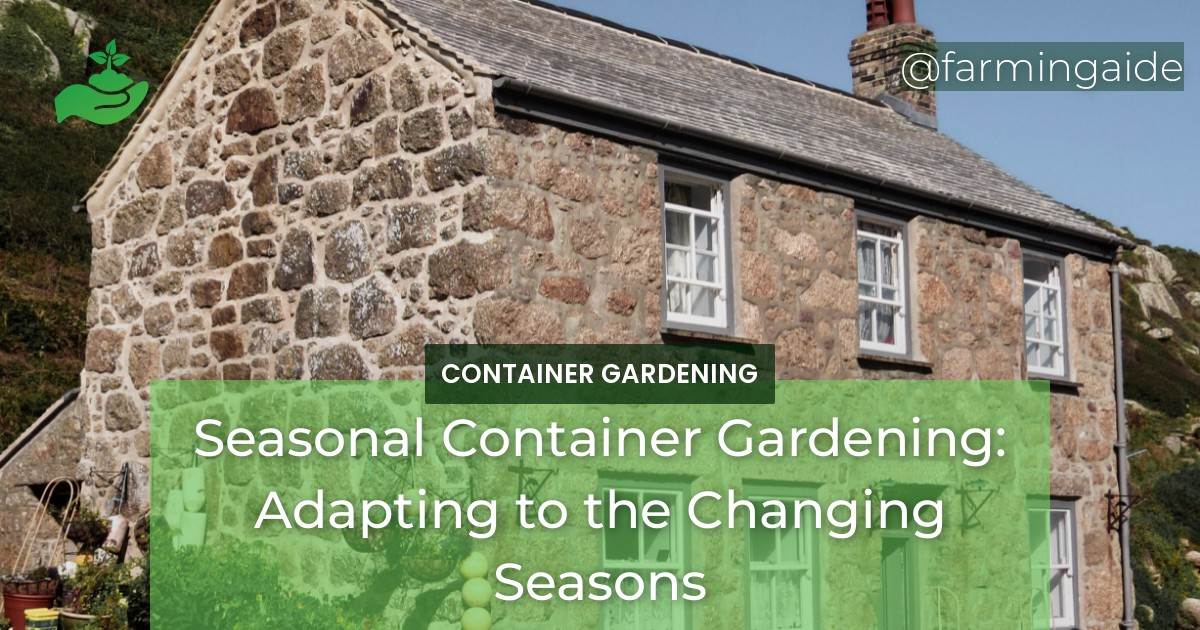Seasonal container gardening is a fun and rewarding way to bring color and life to your outdoor space throughout the year. With a little planning and some basic knowledge, you can create a beautiful and thriving container garden that adapts to the changing seasons. In this article, we’ll explore the benefits of seasonal container gardening, selecting appropriate plants for each season, adapting care routines, and tips for success.
Table of Contents
Benefits of Seasonal Container Gardening
Container gardening allows you to create a miniature ecosystem that is easy to manage and maintain. Whether you have limited outdoor space or just want to add some color to your patio or balcony, container gardening is a great way to get creative with your gardening. Some benefits of seasonal container gardening include:
- Ability to change the look of your outdoor space with each season
- Opportunity to grow a wider variety of plants, regardless of climate
- Low maintenance compared to traditional gardening
- Portability and flexibility to move your plants around as needed
- A great way to experiment with different gardening styles and techniques
Selecting Appropriate Plants for Different Seasons
Choosing the right plants for each season is key to success in container gardening. Some plants flourish in cool temperatures, while others prefer the heat of summer. Here are some examples of plants that are well-suited for each season:
Spring Plants for Container Gardening
- Daffodils
- Tulips
- Lilacs
- Pansies
- Hyacinths
- Crocuses
Summer Plants for Container Gardening
- Geraniums
- Marigolds
- Salvia
- Impatiens
- Zinnias
- Verbena
Fall Plants for Container Gardening
- Mums
- Pansies
- Asters
- Goldenrod
- Pumpkins and gourds
- Ornamental kale and cabbage
Winter Plants for Container Gardening
- Pansies
- Violas
- Primroses
- Cyclamen
- Holly
- Wintergreen
ALSO READ
Adapting Care Routines for Different Seasons
Caring for your plants properly is essential for keeping them healthy and thriving throughout the year. Here are some tips for adapting your care routine for each season:
Spring Care Routines for Container Gardening
- Water your plants regularly to keep the soil moist but not waterlogged
- Fertilize your plants with a balanced fertilizer every two weeks
- Keep an eye out for pests and diseases, and treat them promptly
- Prune dead or damaged growth from your plants to encourage new growth
- Protect your plants from sudden changes in temperature or frost
Summer Care Routines for Container Gardening
- Water your plants deeply and regularly, especially during hot weather
- Fertilize your plants with a high-nitrogen fertilizer every two weeks
- Provide adequate shade for plants that are sensitive to full sun
- Pinch back your plants regularly to encourage bushier growth
- Protect your plants from pests and diseases, especially spider mites and powdery mildew
Fall Care Routines for Container Gardening
- Water your plants regularly, but be mindful of cooler temperatures and less sunlight
- Fertilize your plants with a balanced fertilizer once a month
- Protect your plants from frost and sudden changes in temperature
- Remove dead or damaged growth to prepare your plants for winter
- Provide adequate drainage to prevent root rot
Winter Care Routines for Container Gardening
- Water your plants sparingly, as they will need less moisture during the winter
- Protect your plants from frost and freezing temperatures by moving them indoors or covering them with blankets or frost cloth
- Fertilize your plants sparingly with a low-nitrogen fertilizer every two months
- Prune dead or damaged growth to encourage new growth in the spring
- Provide adequate drainage to prevent root rot
Tips for Successful Seasonal Container Gardening
Here are some additional tips to help you succeed in seasonal container gardening:
Understanding the Climate and Environment
Understanding the climate and environment in which you are gardening is essential for success. Consider factors such as sunlight exposure, wind, temperature, and humidity when choosing plants and care routines.
Choosing the Right Containers
Choosing the right container is also important. Consider factors such as size, material, and drainage when selecting containers for your plants.
Using Suitable Soil and Fertilizers
Using suitable soil and fertilizers is key to keeping your plants healthy. Choose potting mixes that are formulated for container gardening, and fertilize your plants with appropriate fertilizers for each season.
Incorporating Watering and Drainage Techniques
Incorporating appropriate watering and drainage techniques is essential for preventing root rot and other problems. Use watering cans or drip irrigation systems, and make sure your containers have adequate drainage holes.
Pruning and Maintenance Strategies for Container Gardening
Pruning and maintenance strategies are also important for keeping your plants healthy and attractive. Regularly remove dead or damaged growth, and pinch back your plants as needed to encourage bushier growth.
How Can I Adapt my Container Garden to Different Seasons?
Adapting your container garden to different seasons is essential to extend your garden’s season. Choose versatile plants that can thrive in various weather conditions. Utilize protective coverings or indoor space during harsh seasons. Consider planting cold-resistant and heat-tolerant varieties for year-round enjoyment.
Conclusion
Seasonal container gardening is a fun and rewarding way to bring color and life to your outdoor space throughout the year. By selecting appropriate plants for each season, adapting your care routines, and following these tips for success, you can create a beautiful and thriving container garden that adapts to the changing seasons. Whether you are a seasoned gardener or just starting out, container gardening is a great way to get creative and experiment with different gardening styles and techniques.
RELATED ARTICLES:


